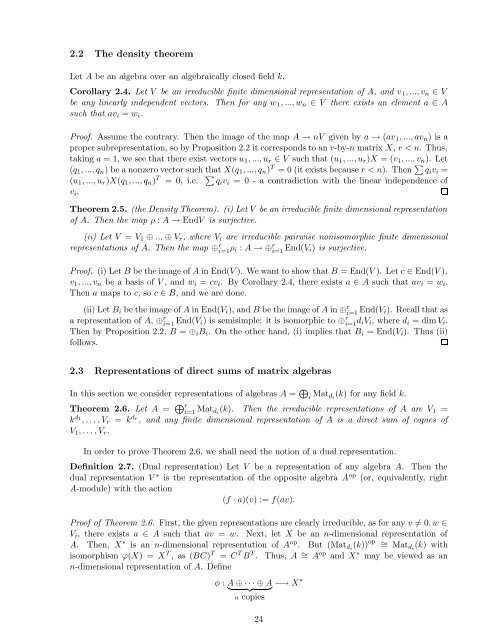Lecture notes for Introduction to Representation Theory
Lecture notes for Introduction to Representation Theory
Lecture notes for Introduction to Representation Theory
Create successful ePaper yourself
Turn your PDF publications into a flip-book with our unique Google optimized e-Paper software.
2.2 The density theorem<br />
Let A be an algebra over an algebraically closed field k.<br />
Corollary 2.4. Let V be an irreducible finite dimensional representation of A, and v 1 , ..., v n V<br />
be any linearly independent vec<strong>to</strong>rs. Then <strong>for</strong> any w 1 , ..., w n V there exists an element a A<br />
such that av i = w i .<br />
Proof. Assume the contrary. Then the image of the map A ⊃ nV given by a ⊃ (av 1 , ..., av n ) is a<br />
proper subrepresentation, so by Proposition 2.2 it corresponds <strong>to</strong> an r-by-n matrix X, r < n. Thus,<br />
taking a = 1, we see that there exist vec<strong>to</strong>rs u 1 , ..., u r V such that (u 1 , ..., u r )X = (v 1 , ..., v n ). Let<br />
(q 1 , ..., q n ) be a nonzero vec<strong>to</strong>r such that X(q 1 , ..., q n ) T = 0 (it exists because r < n). Then ⎨ q i v i =<br />
(u 1 , ..., u r )X(q 1 , ..., q n ) T ⎨<br />
= 0, i.e. qi v i = 0 - a contradiction with the linear independence of<br />
v i .<br />
Theorem 2.5. (the Density Theorem). (i) Let V be an irreducible finite dimensional representation<br />
of A. Then the map δ : A ⊃ EndV is surjective.<br />
(ii) Let V = V 1 ... V r , where V i are irreducible pairwise nonisomorphic finite dimensional<br />
representations of A. Then the map r δ i : A ⊃ r End(V i ) is surjective.<br />
i=1 i=1<br />
Proof. (i) Let B be the image of A in End(V ). We want <strong>to</strong> show that B = End(V ). Let c End(V ),<br />
v 1 , ..., v n be a basis of V , and w i = cv i . By Corollary 2.4, there exists a A such that av i = w i .<br />
Then a maps <strong>to</strong> c, so c B, and we are done.<br />
(ii) Let B i be the image of A in End(V i ), and B be the image of A in r<br />
i=1 End(V i ). Recall that as<br />
a representation of A, r i=1 End(V i ) is semisimple: it is isomorphic <strong>to</strong> r i=1d i V i , where d i = dim V i .<br />
Then by Proposition 2.2, B = i B i . On the other hand, (i) implies that B i = End(V i ). Thus (ii)<br />
follows.<br />
2.3 <strong>Representation</strong>s of direct sums of matrix algebras<br />
In this section we consider representations of algebras A = i Mat d i<br />
(k) <strong>for</strong> any field k.<br />
Theorem 2.6. Let A = r<br />
i=1 Mat d i<br />
(k). Then the irreducible representations of A are V 1 =<br />
k d 1<br />
, . . . , V r = k dr , and any finite dimensional representation of A is a direct sum of copies of<br />
V 1 , . . . , V r .<br />
In order <strong>to</strong> prove Theorem 2.6, we shall need the notion of a dual representation.<br />
Definition 2.7. (Dual representation) Let V be a representation of any algebra A. Then the<br />
dual representation V ⊕ is the representation of the opposite algebra A op (or, equivalently, right<br />
A-module) with the action<br />
(f · a)(v) := f(av).<br />
⇒<br />
Proof of Theorem 2.6. First, the given representations are clearly irreducible, as <strong>for</strong> any v = 0, w <br />
V i , there exists a A such that av = w. Next, let X be an n-dimensional representation of<br />
A. Then, X ⊕ is an n-dimensional representation of A op . But (Mat di (k)) op = ∪ Mat di (k) with<br />
isomorphism (X) = X T , as (BC) T = C T B T . Thus, A ∪ = A op and X ⊕ may be viewed as an<br />
n-dimensional representation of A. Define<br />
θ : A<br />
<br />
·<br />
<br />
· · A<br />
<br />
−⊃ X ⊕<br />
n copies<br />
24

















